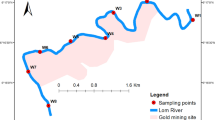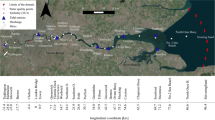Abstract
In the Athabaska sandstone region of northern Saskatchewan, mining and milling of uranium-bearing ore is subjecting, and will continue to subject, surface waters to inputs of soluble heavy metals and uranium and thorium decay series radioisotopes. A mathematical simulation model was developed to assess the role of riverine sediments in regulating soluble concentrations of heavy metals and radioisotopes released to the environment through treated mining and milling process effluents. Specific elements studied included As, Ni, Pb, U, and Ra-226. The model considered that diffusion into sediment porewater and adsorption by sediment particulates from sediment porewater were the two dominant mechanisms regulating sediment loading. Experiments indicated that the equilibrium adsorption behaviour of the heavy metals and radioisotopes studied could be adequately explained using a linear adsorption isotherm, over the range of concentrations expected in the environment. Experimentally determined linear isotherm slopes ranged from 200 ml g−1 to 21 000 ml gl. Diffusion into the effective depth of the sediments (20 cm) was modelled using a quadratic (second order) driving force and a corresponding mass transfer coefficient. The model coefficients were calibrated using field and laboratory data. Results of the modelling suggested that the sediments have a small effect on instream concentrations during the active phases of mining and milling. The sediments were predicted to accumulate sufficient adsorbed mass, during the operational phase of mining and milling, to act as a distributed instream source after completion of milling activities. The significance of this post-operational source was a function of the initial effluent loading, elapsed time and site specific river characteristics.
Similar content being viewed by others
References
Canmet Report 79–21, 1979. Removal of Radionuclides from Process Streams — A Survey. EMR CANADA, Ottawa 171 pp.
Famularo, J., Pannu, A. S. & Mueller, J. A., 1978. Prediction of Carbon Column Performance from Pure-Solute Data, Proc. 51st Annual Conf. of Water Poll. Contr. Fed., Anaheim, California.
Hesslem, R. H., Broecker, W. S. & Schindler, D. W., 1980. Fates of metal radiotracers added to a whole lake, Sediment Water Interactions, Can. Jour. Fish. aquat. Sci. 37: 378–386.
Lerman, A., 1975. Maintenance of steady-state in oceanic sediments. Am. J. Sci. 275: 609–635.
Lerman, A. & Brunskill, G. J., 1971. Migration of major constituents from lake sediments into lake water and its bearing on lake water composition. Limnol. Oceanogr. 16: 880–890.
Peel, R. G., 1979. The roles of slow adsorption kinetics and bioactivity in modelling of activated carbon adsorbers. Ph.D. thesis, McMaster University. 323 pp.
Ramamoorthy, S. & Rust, B. R., 1978. Heavy metal exchange processes in sediment-water systems. Environ. Geol. 2: 165.
Schindler, D. W., Hesslein, R. H., Wagemann, R. & Broecker, W. S., 1980. Effects of acidification on modilization of heavy metals and radionuclides from the sediments of a fresh water lake. Can. Jour. Fisch. aquat. Sci. 37: 373–377.
Schindler, D. W. & Holmgren, S. K., 1971. Primary production and phytoplankton in the experimental lakes area, northwestern Ontario, and other low-carbonate waters and a liquid scintillation method for determining14C activity in photosynthesis. J. Fish. Res. Bd Can. 28: 189–201.
Snodgrass, W. J., 1980. Personal communication, McMaster University.
Author information
Authors and Affiliations
Rights and permissions
About this article
Cite this article
Holloran, M. Model for instream regulation of radioisotopes and heavy metals in riverine waters subjected to a uranium mill discharge. Hydrobiologia 91, 175–188 (1982). https://doi.org/10.1007/BF00940108
Issue Date:
DOI: https://doi.org/10.1007/BF00940108




